The first question an amateur astronomer often asks after buying a telescope is "How far into the night sky can I see with my equipment?" The answer depends on the size of the telescope or binoculars, but also other aspects like the darkness of the sky and the seeing conditions.
A distant celestial object that’s plainly visible from an isolated country location might barely show up among the light pollution from nearby towns and cities.
Other variables have an impact on how far an astronomer can see, such as how good your vision is, the quality of your telescope’s optics and subtle differences between dark-sky sites.
We’ve put together 9 progressively more distant deep-sky objects visible through binoculars and telescopes.
Each object represents a practical distance barrier as seen through an instrument no larger than the one we’ve specified, be it 10x50 binoculars or a 16-inch telescope.
All are visible from mid-northern latitudes and are well-placed before midnight during the stated times.
Remote objects tend to be faint, but pushing the limits of your telescope to locate these deep-sky objects can be very satisfying.
1
The Orion Nebula
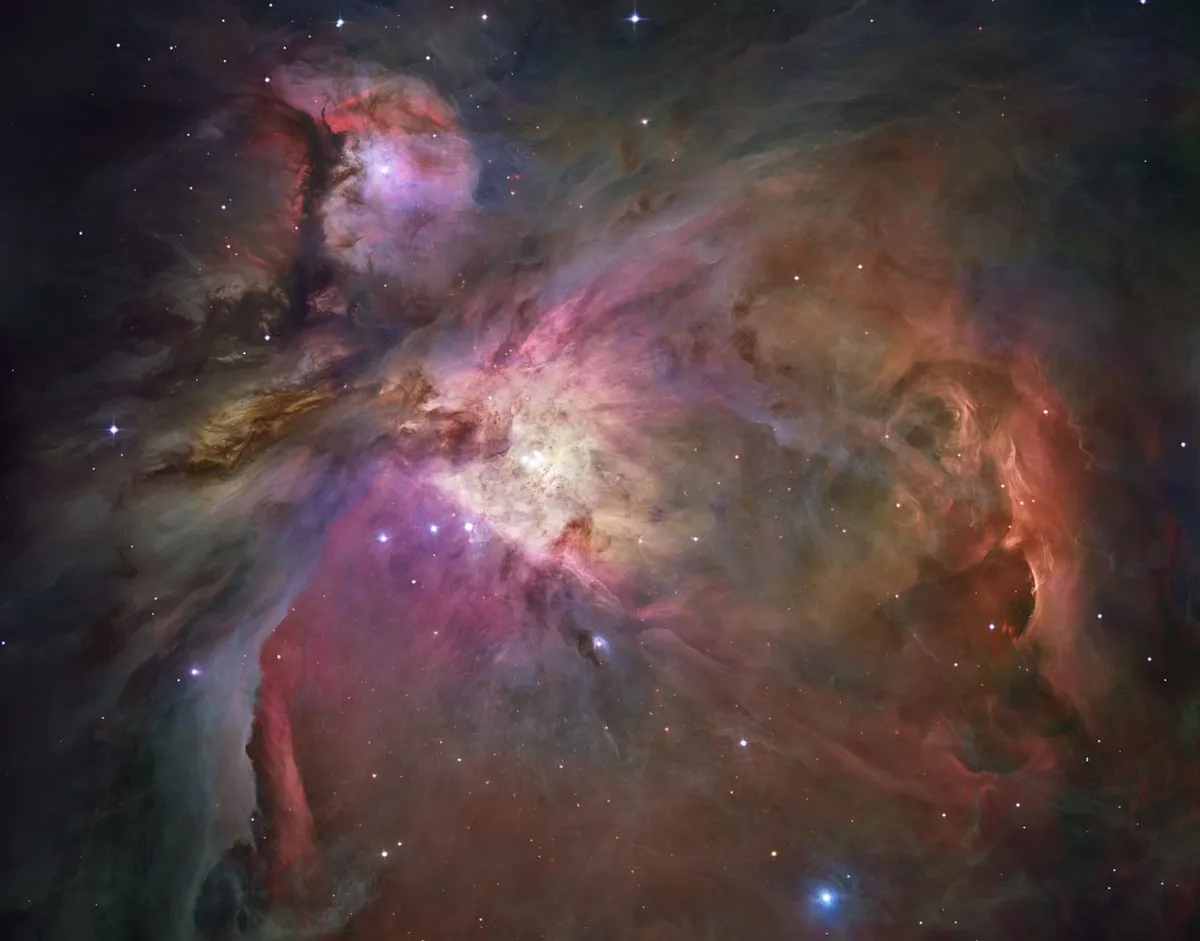
Distance: 1,500 lightyears away
What is it?
The Orion Nebula, also known as M42, is an emission nebula – a cloud of dust and gas heated to incandescence by the energetic young stars inside it.
What equipment do I need to see it?
All you need are your bare eyes.
From a suburban location, you can see the Orion Nebula as a fourth magnitude blur in Orion’s Sword. Binoculars reveal two stars, Theta 1 (θ1) and Theta 2 (q2) Orionis, embedded in a grey mist.
A 4-inch reflector will resolve Theta 1 into a compact quartet, called the Trapezium, at the heart of the nebula, with wispy wings of nebulosity 0.5° long curling away from it.
When is the best time to see it?
Orion is well placed from December through to March.
The best time to observe M42 is in late February, when it is at its highest.
How do I find it?
Orion is easy to pick out.
Look in the middle of the constellation for the row of three stars (Orion’s Belt), then drop southward to the Sword, a line of three fainter ‘stars’ aligned north-south.
The misty ‘star’ in the middle is M42.
2
The Double Cluster
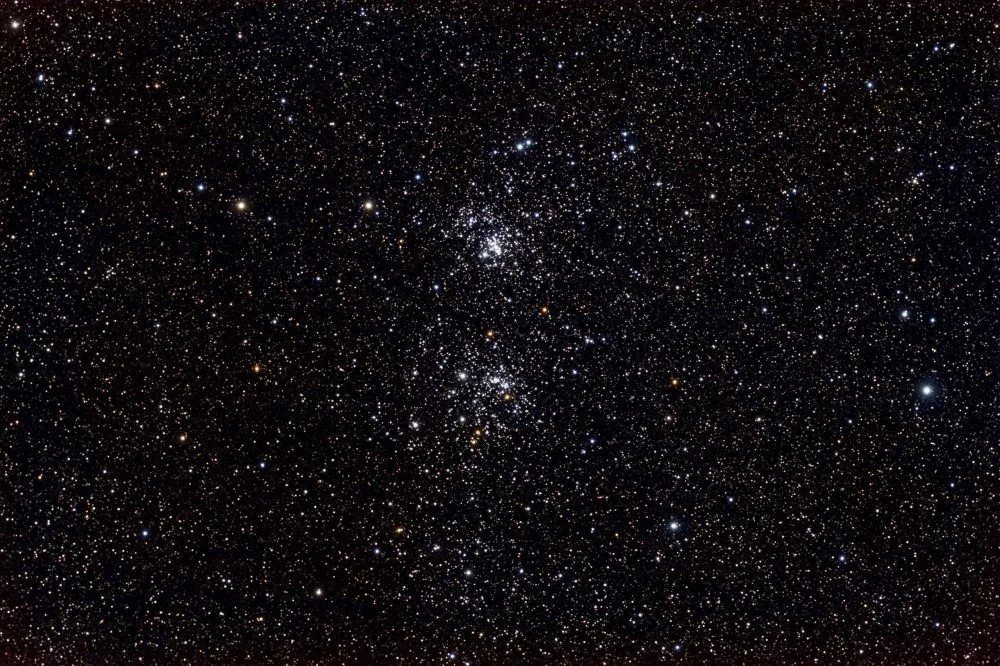
Distance: 7,000 lightyears away
What is it?
NGC 869 and NGC 884 together form the Double Cluster.
They are side-by-side open star clusters in the constellation of Perseus. Although they occupy less than 1° of sky, these stellar families aren’t true neighbours. NGC869 is about 7,000 lightyears away, while NGC 884 is several hundred lightyears further out.
What equipment do I need to see it?
Shining at fifth magnitude, the Double Cluster is beyond naked-eye range for most city stargazers. However, a pair of 7x50 binoculars show this deep-sky duo as adjacent clumps of haze pierced by a few stars. The clusters really dazzle through a 4-inch scope.
When is the best time to see it?
Look for the Double Cluster climbing in the northeast in late summer. It arcs high overhead in autumn and most of winter.
How do I find it?
Spotting the Double Cluster is fairly easy because it lies near the well-known ‘W’-shaped star pattern of Cassiopeia. It sits a third of the way from Eta (η) Persei to third magnitude Delta (δ) Cassiopeiae, as shown below.
3
The Great Cluster
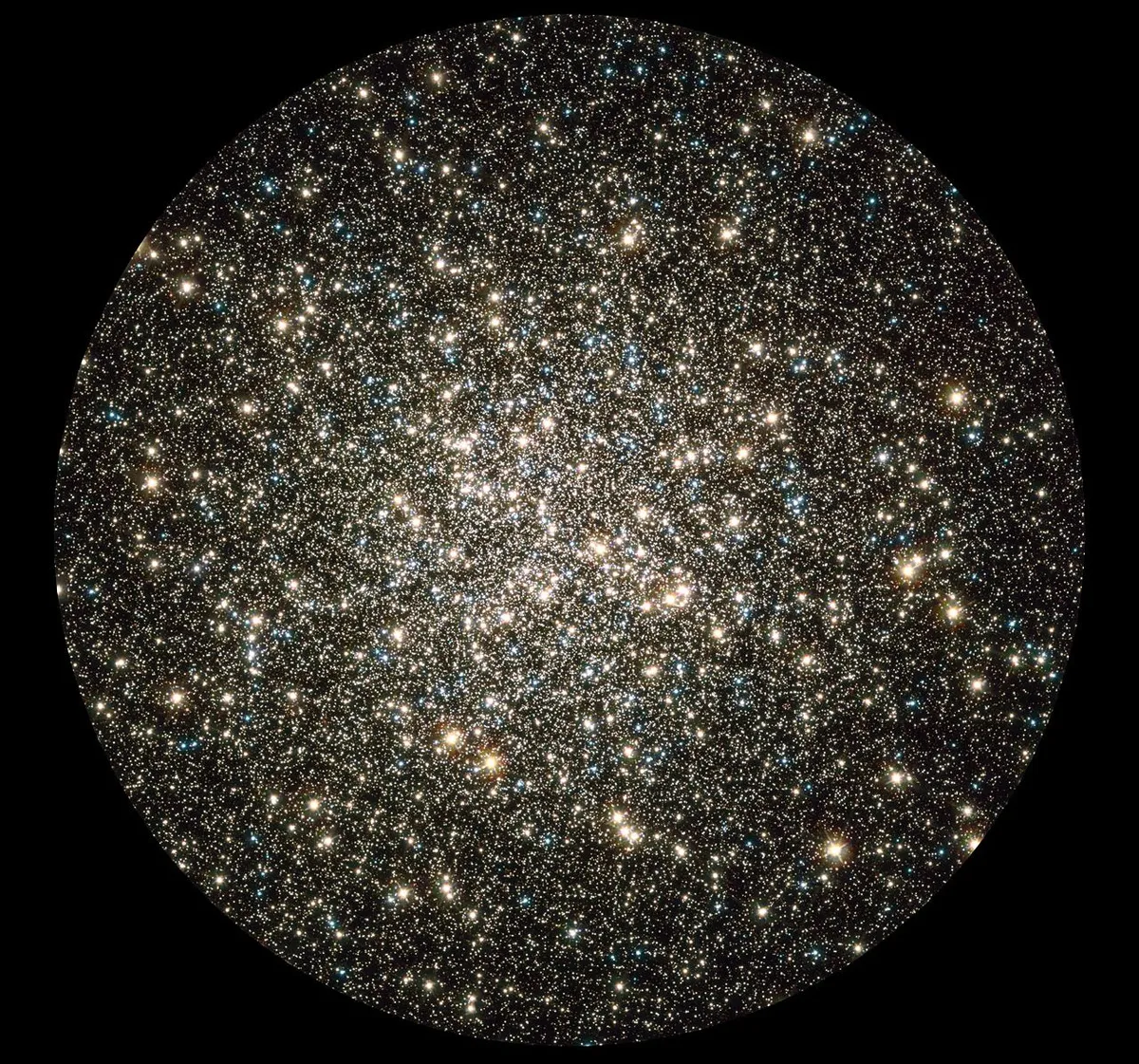
Distance: 21,000 lightyears away
What is it?
This globular cluster in Hercules is a densely packed ball of several hundred thousand ancient stars, fairly large at 17 arcminutes in diameter and remarkably bright at magnitude +5.8.
The Great Cluster, or M13, is considered the finest of the globular clusters north of the celestial equator.
What equipment do I need to see it?
M13 is visible in binoculars from most back gardens.
With a pair of 10x50s you’ll see a tiny, featureless smudge – evidence that M13 is triple the distance of the Double Cluster.
The brightest cluster members are twelfth magnitude – barely within range of a 4-inch scope.
Still, with over 90x magnification, the view is tantalising: a granular globe flecked with pinpricks of light.
When is the best time to see it?
The Great Cluster arcs overhead from late spring to early autumn.
How do I find it?
M13 sits on the west side of the Keystone – a box-like shape outlined by four stars in Hercules.
Your binoculars should pick up a fuzzy dot two-thirds of the way from Zeta (ζ) to Eta (η) Herculis.
4
M2
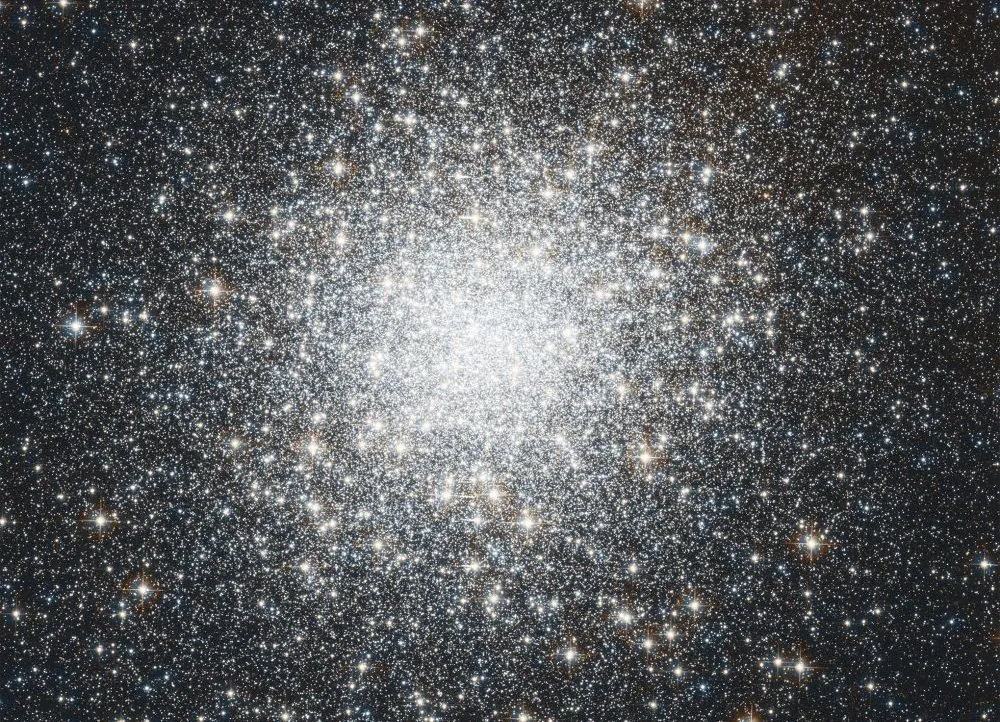
Distance: 40,000 lightyears away
What is it?
Like M13 in Hercules, M2 in Aquarius is a globular cluster, one of 150 scattered in an immense halo around our Galaxy.
If you can detect these two, you’re extending your gaze well into our Galaxy’s distant backwaters.
What equipment do I need to see it?
M2 is smaller (at 16 arcminutes) and dimmer (mag. +6.6) than M13, so city-based observers might not spot it in binoculars. It will show up in a 4-inch scope, though.
Since the brightest cluster members are only thirteenth magnitude, M2 is a concentrated blob that doesn’t resolve into stars even at highest power.
An 8-inch does better, revealing a slightly elliptical structure that brightens gently toward the middle.
When is the best time to see it?
Hanging just below the celestial equator, M2 is well placed from mid-summer to late autumn.
How do I find it?
M2 resides in northern Aquarius below Pegasus.
Extend a line southwest across the Great Square of Pegasus to reach Beta (β) Aquarii, then aim your scope 4.25° north of Beta to spot M2.
5
The Andromeda Galaxy
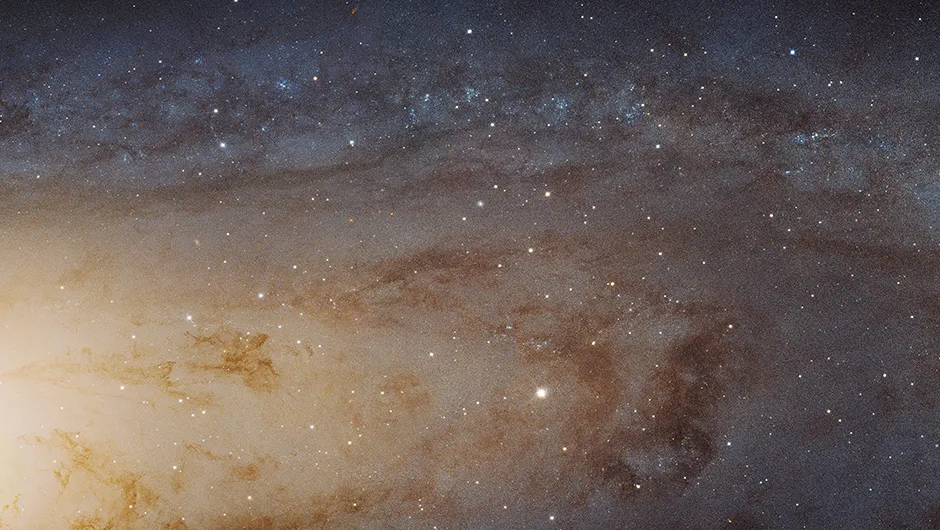
Distance: 2.4 million lightyears away
What is it?
The Andromeda Galaxy, M31, is the closest big spiral to our Milky Way Galaxy.
Glowing at mag. +3.5, this ‘nearby’ galaxy is also the most distant sky object easily visible to the naked eye from a dark country site.
What equipment do I need to see it?
From a suburban site you’ll need a 4-inch reflector to spot M31, and it rarely shows more than the condensed central portion.
Away from town the same scope reveals the whole galaxy: the bright middle is elliptical in form and it spreads into an elongated disc spanning at least 2°.
In an 8-inch scope two parallel dust lanes provide a sharp edge to one side of the disc.
Both scopes reveal Andromeda’s companion galaxies, M32 and NGC 205.
When is the best time to see it?
M31 is well placed from late summer through to mid winter.
How do I find it?
Imagine a line extending northeast across the Great Square of Pegasus to a string of stars comprising Beta (β), Mu (μ), and Nu (ν) Andromedae.
our prize is just below Nu, as shown below.
6
M49
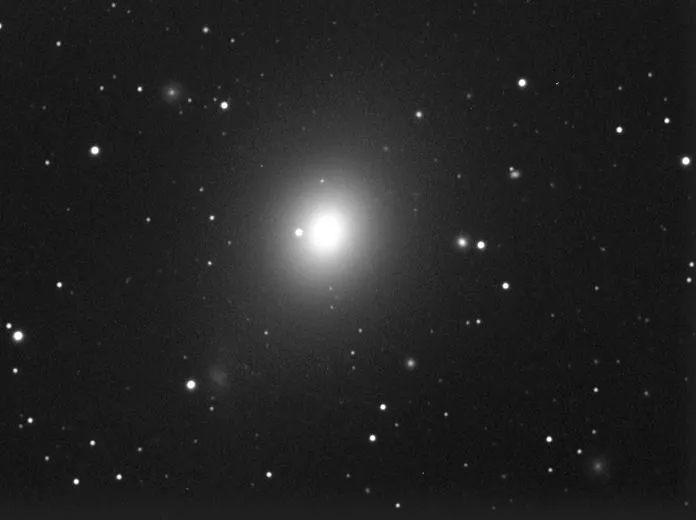
Distance: 72 million lightyears away
What is it?
M49 represents a 30-fold leap beyond M31.
This mag. +8.4 elliptical galaxy is the brightest member of the Virgo Galaxy Cluster, the nearest family of galaxies beyond our Local Group.
What equipment do I need to see it?
Away from city lights, you can detect M49 in 10x50 binoculars.
You might pick up a few slightly fainter smudges in the Virgo Cluster as well.
They’re all roughly as far away as M49 and collectively represent the ‘distance barrier’ for binoculars at a reasonably dark country location.
However, an 8-inch reflector at around 100x magnification shows M49 as a 10 arcminute wide oval smudge with a tiny, bright core.
When is the best time to see it?
M49 is a convenient target for most of the spring.
How do I find it?
From the bright star Spica, jump northwest to Gamma (γ) Virginis, then turn northeast to Delta (δ).
From Delta head 5° to the sixth-magnitude star 31 Virginis, then veer west-northwest for 2.75° to a star of similar brightness. M49 lies 0.5° northwest of that star.
7
The Coma Cluster
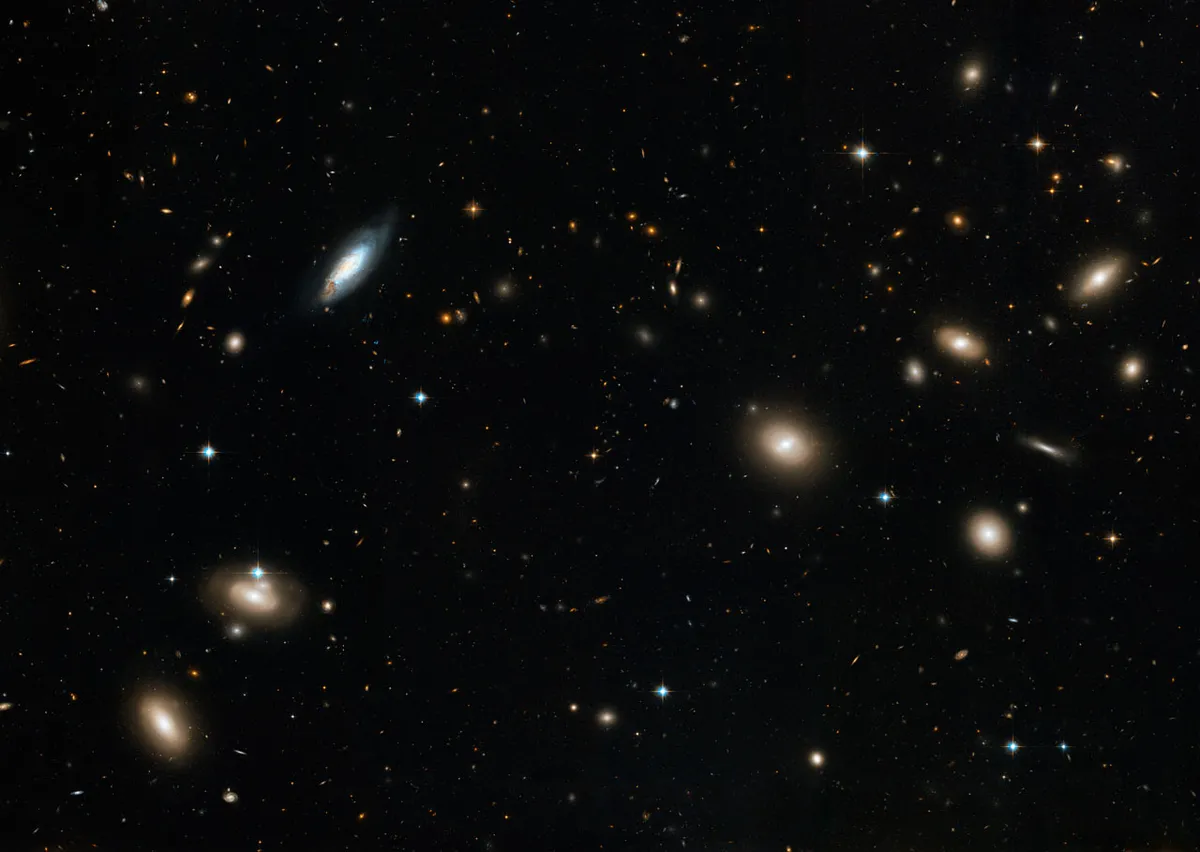
Distance: 300 million lightyears away
What is it?
Our next step outward, the Coma Cluster, is known fully as the Coma Berenices Galaxy Cluster, or Abell 1656.
This 4°-wide cloud is populated with hundreds of galaxies around 300 million lightyears distant.
What equipment do I need to see it?
The anchors of the Coma Cluster are the galaxies NGC 4874 and NGC 4889, which are aligned east-west just 8 arcminutes apart. NGC 4889 is mag. +11.5 and about 3 x 2 arcminutes in extent.
NGC 4874 is slightly smaller and two-tenths of a magnitude fainter.
These far-away objects float like spectres at the threshold of vision in a 4-inch reflector at about 90x magnification – the glare from a seventh magnitude star just north of NGC 4874 doesn’t help!
When is the best time to see it?
April and May is prime time for the Coma Cluster.
How do I find it?
The Coma Cluster lies one-quarter of the way from Beta (β) to Gamma (γ) Comae Berenices, which is 10° west. The mag. +7.0 star noted earlier is a convenient stepping stone to the galaxies.
8
Hercules Galaxy Cluster

Distance: 500 million lightyears away
What is it?
The Hercules Galaxy Cluster, or Abell 2151, lies at the heart of the vast Hercules Supercluster.
At least half a billion lightyears away, the cluster is an alluring, though elusive, prize in our distance sweepstakes.
What equipment do I need to see it?
The cluster occupies a 1°-wide patch of sky.
A dozen pale NGC galaxies, plus many others, are crammed into the central 20-arcminute-wide field of Abell 2151.
Two or three of the most luminous (none of them are more than 14th magnitude) show in the high-power field of a 10-inch reflector on the finest nights.
When is the best time to see it?
Abell 2151 rides high in the sky from late May until early August.
How do I find it?
From the star Zeta (ζ) Herculis at the southwest corner of the Keystone asterism, move southward to Beta (β).
Now slant southwest through Gamma (γ) to Kappa (κ).
A sharp turn west for 1.75° will take you to the star 5 Herculis.
A seventh-magnitude star just 37 arcminutes east is your entry point to the cluster.
9
3C 273
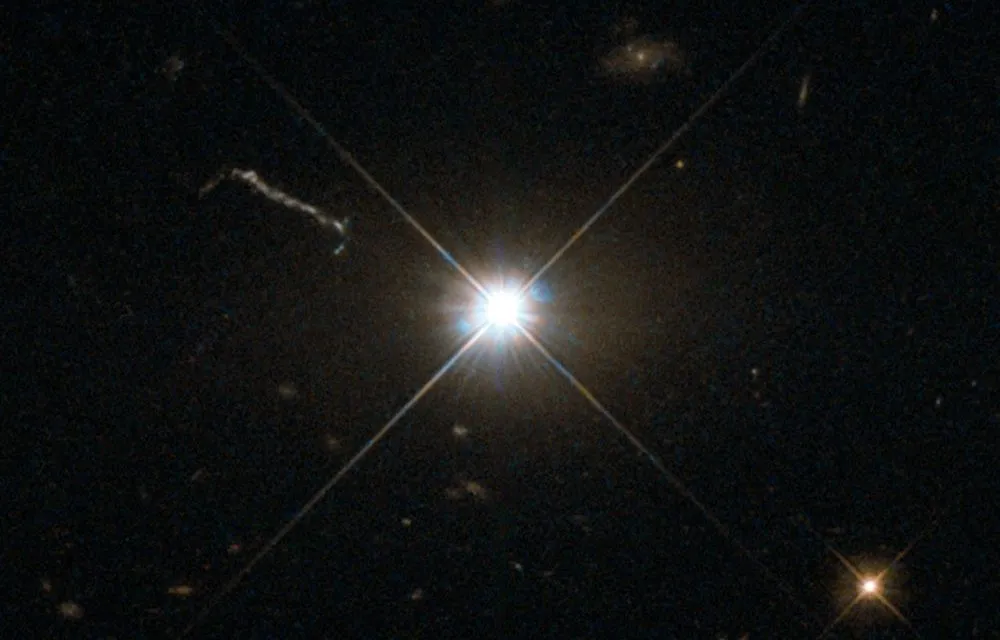
Distance: 2 billion lightyears away
What is it?
3C 273 is the brightest ‘quasi-stellar’ object, or quasar, in the sky.
Compact and extremely energetic, quasars are believed to be the manifestation of active supermassive black holes at the centres of galaxies.
Quasars are also incredibly remote; 3C 273 in western Virgo represents the distance barrier for most amateurs.
What equipment do I need to see it?
Under a dark sky 3C 273 is visible in a 10-inch reflector as a bluish, mag. +12.8 star. If you can detect Pluto with your scope, you should be able to catch the quasar.
When is the best time to see it?
This dim quasar is accessible on any clear spring evening.
How do I find it?
Your quarry is part of a triangle formed by Gamma (γ), Eta (η), and 16 Virginis.
Look for a seventh magnitude star one-quarter of the way from 16 Virginis back to Gamma.
The quasar is 38 arcminutes east of that seventh magnitude star. 3C 273 looks stellar, making it difficult to distinguish from faint stars around it.
To identify it, you’ll need a chart plotting stars down to 13th magnitude.
